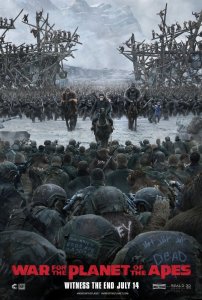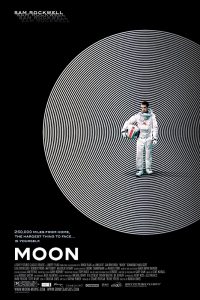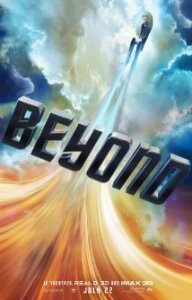The Apes of Wrath: A Review of War for the Planet of the Apes

To my knowledge, there are no announced plans for a fourth film in the recent Planet of the Apes prequel series, and everything about Matt Reeves’s War for the Planet of the Apes thankfully suggests a desire to bring its series to an end as a trilogy. True, much of the film simply carries on the apes-versus-humans saga unveiled in the second film, Dawn of the Planet of the Apes (2014 – review here), but eventually all of the major story lines are concluded in a satisfying manner that precisely lays the groundwork for the transformed world observed in the original Planet of the Apes (1968). Thus, the fear expressed in my review of Dawn of the Planet of the Apes – that filmmakers were preparing for an endless series of iterative Apes films – was unfounded, as that film’s failure to significantly advance its plot can instead be attributed to the familiar problem encountered by anyone writing the second work in a trilogy: the need to keep the characters in motion while postponing all significant developments for the final installment. The sense that these three films constitute a trilogy is enhanced by what seems to be their deliberate shifts in perspective: the first film almost entirely foregrounds contemporary human society; the second film alternates between the activities of beleaguered humans and the activities of Caesar’s apes; and the third film almost entirely focuses on the apes. One cumulatively observes, then, a gradual transition from a world dominated by humans to a world dominated by apes.
The problem with endeavoring to craft a prequel to the original five films, of course, is that they account for a society of intelligent apes and servile, speechless people in two different and contradictory fashions: the first film and its immediate sequel, Beneath the Planet of the Apes (1969), indicate clearly that future humans destroyed themselves in a global nuclear war, initiating a process of evolution that allowed apes to advance while humans devolved. Yet the final three films confusingly suggest that intelligent apes first thrived within human society, and growing conflict between apes and humans soon led to the downfall of civilization, though there are hints that time travel has triggered an alternate history with an uncertain outcome. These prequel films partially emulate the second scenario, although their intelligent apes came about as a result of ill-advised scientific research, not time-traveling apes. As I indicated while reviewing the first film, Rise of the Planet of the Apes (2011 – review here), these disparate explanations reflect changing concerns about the greatest dangers facing humanity, as we now worry less about a nuclear holocaust or racial and ethnic strife and worry more about scientific experiments getting out of control. This film adds the further idea that our unwise scientific initiatives are one aspect of a reckless impulse to “bend nature to our will,” as Colonel McCullough (Woody Harrelson) explains, so that by means of advanced apes, “nature has been punishing us for our arrogance.” But the theme of nature versus civilization has always been implicit in these films, as virtuous apes like Caesar (Andy Serkis) prefer to live in the forest while evil humans huddle within cities and military compounds. As if to underline the point that we should preserve and value the natural world, Caesar once manages to save his life by literally hugging a tree.
This film introduces another interesting variation in the original story’s future history. Charlton Heston’s Planet of the Apes clearly conveys that it took many, many generations for humanity to degenerate into savagery and for apes to develop speech and intelligence. Yet here, it only takes about fifteen years for humanity to descend to the point of complete collapse, and we even encounter two children – Caesar’s young son Cornelius (Devyn Dalton) and a human girl named Nova (Amiah Miller) – who are destined to become Heston’s adult friend and companion when he and the other astronauts of the Icarus, referenced in Rise of the Planet of the Apes, presumably return to Earth after a few decades, not a few millennia. One might imagine that as our species develops more and more wondrous new technologies and ways to improve our lives, we would grow more and more confident in our ability to sustain civilization through adverse conditions for long periods of time; instead, it seems, we now view our civilization as amazingly fragile, likely to quickly fall apart as a result of a single crisis. One could also cite as evidence the novel and film The 5th Wave (2016 – review here), wherein it requires very little time for invading aliens to bring humanity to its knees.
A lack of confidence in humanity’s ongoing progress is also reflected in another trend I have commented on, recurrent visions of what I term a “Grapes of Wrath future” wherein people have reverted to the technology and lifestyles of the Great Depression. And in its own way, War for the Planet of the Apes falls into this pattern, as only its future’s weaponry is truly advanced, which could be viewed as an expedient conceit that enables filmmakers to provide their mandated quota of violence and explosions. Otherwise, the apes eschew all machines, and the humans all seem to be living in ramshackle structures with dusty kitchens filled with antiquated devices. Instead of using a microwave oven, McCullough heats his food with a crude, improvised burner; a man is seen gathering firewood to keep his house warm; computers are never observed, and while one can assume that the internet is no longer functioning in this devastated world, computers would undoubtedly be useful in other ways to someone trying to manage an army and a prison camp.
While I have pondered other reasons for this proclivity for a future that resembles the past, this film inspires a practical explanation: filmmakers depicting the future frequently borrow from film genres set in the past, and hence naturally tend to fill their films with accoutrements from the past. Certainly, the film’s opening battles, like the conflicts in James Cameron’s Avatar (2009 – review here), recall the Vietnam War, as sinister Caucasian soldiers armed with high-tech weapons advance into a forest to attack innocent indigenous residents, and this film explicitly references America’s conflict with the Viet Cong with a message posted at McCullough’s headquarters, “The only good Kong is a dead Kong.” The crazed McCullough’s shaved head makes him seem a homage to Marlon Brando’s crazed Kurtz in the classic Vietnam War film Apocalypse Now (1979), as also suggested by another item of observed graffiti, “Ape-pocalypse Now,” and a final scene of attacking helicopters that cries out to be accompanied by the “Ride of the Valkyries.” Further, as the story begins to focus on the apes’ efforts to escape from a prison camp by means of a tunnel, one is reminded of another war film, The Great Escape (1963). It is telling, then, that the film’s credits list a “military advisor,” but not a scientific advisor (though they did employ the Dian Fossey Institute for “ape vocal research”).
In addition, recurring images of individuals on horseback carrying shotguns recall countless westerns; indeed, one chase scene, where one individual on horseback fires a shotgun back at the three individuals on horseback who are pursuing him, could be spliced into an old western film, as long as no one notices that the individuals on horseback are apes. The humans also brand their servant apes, like cattle, with the symbols for alpha and omega that McCullough uses to represent his movement (and his fears of humanity’s demise), and the whole scenario of brutal men oppressing peaceful indigenous people recalls revisionist westerns like Cheyenne Autumn (1964) that describe America’s nineteenth-century mistreatment of Native Americans. The sense that this film is replicating war movies and westerns is heightened when McCullough likens himself and Caesar to three other pairs of opposing leaders: Ulysses G. Grant and Robert E. Lee, the Duke of Wellington and Napoleon Bonaparte, and George Armstrong Custer and Sitting Bull; the final pairing foreshadows the film’s inevitable conclusion, as McCullough is destined to play Custer to Caesar’s Sitting Bull.
A reference to another film – Ronald Reagan’s Bedtime for Bonzo (1951), a slogan on one soldier’s helmet – might seem a meaningless bit of humor, as nothing about this film seems to resemble that gentle comedy. Yet strangely there is a connection to pursue, because Reagan’s professor adopts that chimpanzee in order to prove that someone’s upbringing, not their genes, determines their character, and this movie makes the same point. Caesar is initially kindly because he was treated kindly by scientist Will Rodman, but he is so warped by the tragedy of his son’s murder that he is becomes obsessed with killing McCullough, even while recognizing that his feelings are wrongheaded. McCullough becomes unhinged because, fearing that his son might spread a dangerous plague, he is driven to kill his own son. Throughout the film, for these and other reasons, both Caesar and McCullough constantly seem to be angry, which at times grows tiresome; as I noted while reviewing Dawn of the Planet of the Apes, the earlier films were improved by their lighter moments, yet there is absolutely no comic relief in this film.
One might also ask: why is it that the fates of their sons are so crucial in influencing their thoughts and behavior? After all, McCullough also killed Caesar’s wife, but that clearly is less important to the ape; Caesar always displays the greatest amount of emotion when he encounters or loses contact with his other son Cornelius; when the apes’ original plans are thwarted, he devises an alternate way to rescue their children; and he finally seems to achieve some peace of mind when he is assured that Cornelius has survived their ordeal in the prison camp. To have a son, McCullough must have also had a wife or girlfriend, who presumably became one of the innumerable victims of the plague, but he never mentions her and apparently does not even have a picture of her. But at the moment in the film when he seems most depressed, he has been looking at a picture of his dead son. McCullough also conveys the special importance of sons when he explains that he killed his son to more broadly ensure that humanity would survive: “if we lose,” he concludes, “it will be the end of our kind. We will become a planet of apes, with humans as cattle.” Similarly, Caesar’s son and the other ape children represent the only way to perpetuate their new race of intelligent apes.
When people fear imminent annihilation, they often turn to religion as a mechanism for perhaps avoiding their fate through prayer and reformation or at least consoling themselves with visions of an afterlife; yet none of this film’s characters evidence much interest in this option. Among the humans, one notes only that McCullough wears a cross and describes the battle between humans and apes as a “holy war”; his assistant is called Preacher (Gabriel Chavarria); and the tunnel used by plague victims escaping from confinement is labeled, “This way out of Hell.” But no one prays or crosses themselves or says a word about God. (For that matter, the only religious people I can recall in any of the Planet of the Apes films are the atomic-bomb-worshipping mutants of Beneath the Planet of the Apes.) As for the apes, they appear to be developing a society that lacks any religion at all, unless one counts their fervent devotion to Caesar, who is sometimes likened to Jesus Christ (McCullough exclaims to him, “Jesus Christ, you are impressive,” and later crucifies him) and sometimes likened to Moses (destined to lead his people to the Promised Land without ever entering it). To develop the argument that the apes are establishing a secular utopia, one would note these as its characteristics: as noted, except for weaponry, they eschew technology and religious beliefs; they do not wear clothes, even while trekking through the snow (though the ape known as Bad Ape [Steve Kahn] does wear a jacket when he is cold, perhaps to anticipate the clothed apes observed in the original films); except for Caesar’s informal leadership, which is clearly not absolute, they lack a system of government; and there is no formal education, as children learn by hanging around and observing adults.
An unusual aspect of their eventually utopian existence emerges from pondering a subject that I always find peculiarly interesting: trying to nail down precisely where the events in the film are purportedly taking place. We know from previous films that the apes’ forest home is near San Francisco; two ape scouts travel east and report that if one crosses mountains and a desert, a remote and paradisiacal environment awaits them; when most of the apes are captured by McCullough, they are taken to his headquarters, which we eventually learn is a detention facility on the border between California and Oregon; other apes seeking McCullough travel north, experiencing snowstorms and encountering Bad Ape, who once lived in the “Sierra Zoo” (presumably the Sierra Safari Zoo in nearby Reno, Nevada); and their final home will be a verdant valley with a lake that one guesses is in Colorado. In other words, this film’s apes are constantly striving to get out of California, either by traveling north or east, and they finally achieve happiness after they have permanently escaped from California. Their perambulatory aversion to California is unexpected, given that their tree-hugging philosophy would seem to perfectly accord with the beliefs of California’s Governor Jerry Brown and most of his constituents, but one must also recall that the San Francisco area has now been enshrined as the world’s capital for evil or misguided scientific research, as observed in Rise of the Planet of the Apes, Transcendence (2014 – review here),The Lazarus Effect (2015 – review here), and other films. In contrast, to my knowledge, no lethal plagues or murderous monsters have ever originated in Colorado.
The apes’ quest for utopia can also be related to a rejection of all-American values, presumably conducive to the sorts of violence and racism that Planet of the Apes films always oppose. This is conveyed by the film’s noted resonances with the Vietnam War, and one also notes that when McCullough’s soldiers begin rounding up the apes to engage in their daily forced labor, they do so to the accompaniment of “The Star Spangled Banner.” Most significantly, their camp is adorned with a huge American flag that, during a final attack, is set on fire – that form of anti-American protest famously sanctioned by the Supreme Court – and when Caesar attempts to cling to the burning flag to break his fall, it proves to be of no assistance. Understandably, however, the film’s criticisms of America are muted and sporadic, since even in a globalized market, some revenue from American theatres remains essential to success.
And I suspect that this film, which I liked more than I anticipated, will earn a lot of money both here and abroad, and that will create some pressure to produce a sequel that I believe nobody involved in this film really wants. The only logical continuation of this film would be a remake of the original Planet of the Apes, yet given this film’s accelerated pace, there would be no time to bury the Statue of Liberty, and I have no ideas for other sequels except for those presented in earlier reviews. The ideal solution, of course, would be to reassemble the creative team behind this film and assign them to come up with something entirely new and different; but alas, we do not live in a utopia.
–Gary Westfahl
Directed by Matt Reeves
Written by Mark Bomback and Matt Reeves, based on characters created by Rick Jaffa and Amanda Silver, based on a novel by Pierre Boulle (uncredited) and a screenplay by Michael Wilson and Rod Serling (uncredited)
Starring Andy Serkis, Woody Harrelson, Steve Zahn, Karin Konoval, Amiah Miller, Terry Notary, Ty Olsson, Michael Adamthwaite, Toby Kebbell, Gabriel Chavarria, Judy Greer, Sara Canning, Devyn Dalton, Alex Paunovic, Alessandro Juliani, Max Lloyd-Jones, Mercedes de la Zerda, and Chad Rook
Gary Westfahl has published 25 books about science fiction and fantasy, including Science Fiction Quotations: From the Inner Mind to the Outer Limits (2005), The Spacesuit Film: A History, 1918-1969 (2012), A Sense-of-Wonderful Century: Explorations of Science Fiction and Fantasy Films (2012); excerpts from these and his other books are available at his World of Westfahl website. He has also published hundreds of articles, reviews, and contributions to reference books. His most recent books are the three-volume A Day in a Working Life: 300 Trades and Professions through History (2015) and An Alien Abroad: Science Fiction Columns from Interzone (2016), now available from Wildside Press; ; his forthcoming books include Arthur C. Clarke and a collection of essays from the Eaton Conferences on Science Fiction and Fantasy Literature.









“In contrast, to my knowledge, no lethal plagues or murderous monsters have ever originated in Colorado.”
The Overlook Hotel in King’s “The Shining” is located in Colorado! 😉
Please be sure to include a “spoiler alert” in the future if you’ve got spoilers. Thinking here of your description of Caesar’s fate. Thanks.
P.S. I enjoyed listening to your Great Courses lectures, “How Great SF is Made” (or something like that; don’t have it in front of me).
Thanks for your comment, but the Great Courses lecture was by Gary K. Wolfe, a book reviewer for Locus Magazine, not Gary Westfahl, the film reviewer for Locus Online.